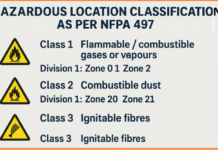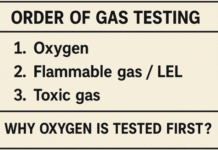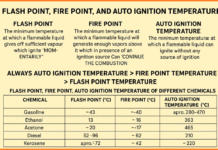For moving material normally two types of equipment are used. Conveyors are used when the path is fixed and industrial trucks are used when the path is free.
Various types of conveyors and mono-rail systems are used in many industries to eliminate manual labor to expedite the movement of materials and also to facilitate the processing or assembling. Belt conveyors are widely used and they are of flat or trough type and can be horizontal or inclined. They are used for handling almost all the materials of the modern industry including coal, coke, grain, fertilizers and building materials such as sand and gravel.
Important Safety measures in Conveyors
- Conveyors shall be so constructed and installed as to avoid hazardous points between moving and stationary parts or objects. Gears, sheaves, sprockets, and all moveable parts shall be securely guarded.
- Where workers have to cross over conveyors, regular crossing facilities affording safe passage and adequate lighting shall be provided. To cross underneath, at least 7 feet headroom is required. Crossovers should be with bridges, stairs, and handrails.
- Conveyors shall be provided at loading and unloading stations and at other convenient places with devices (pull wire) for stopping the conveyor in an emergency. A pull wire at intervals of 8 m should be provided.
- When two or more conveyors are operated together, the controlling device shall be so designed that no conveyor can feed on to a stopped conveyor. This may be interlocked.
- Where conveyors extend to points not visible from the control station, they should be equipped with goings or signal lights to be used by the operations before starting the machinery so as to warn persons who might be in the position of danger.
- Conveyors shall be provided with an automatic and continuous lubrication system or with lubricating facilities so arranged that oiling and greasing can be performed without the oiler coming into dangerous proximity of the moving parts.
- Workers should not ride on conveyors.
- For repair/maintenance work, power must be totally stopped and danger-tag should be displayed. Belt cleaning by flammable solvent should be avoided.
- Tension pulley – nips and idler rollers should have the fixed guard on their complete length of movement.
- Moveable dead counterweights should also be similarly guarded.
- Static charge collectors should be provided close to the outrunning sections of the drive pulleys and idlers.
- Elevated conveyors should have a walkway with a toe board (10 cm) and handrail (1 m) all along the length. Flooring should be non-slip type, particularly on sloping walkways. Handrail should also be provided on the belt side. Stop cord must be within easy reach.
- Underpasses should have firm ceiling. Guards should be provided below all conveyors passing over rodes, walkways and work areas
- Conveyors running in tunnels, pits, etc. should be provided with sufficient lighting, ventilation, drainage, guards, escape ways and maintenance clearance.
- If the hopper is used at the floor to feed conveyor, the grill or guard should be provided to prevent failure of a person inside, Scrapper may be provided between the hopper bottom and the moving conveyor. They will restrict the excess flow of material and alert any person under passing it.
- If two or more conveyors operate in series, it should be so interlocked that if one conveyor stops all conveyors feeding it are also stopped.
- In the case of reversing or running away possibility, anti-runaway and backstop devices should be provided so that the load cannot slide or fall in the event of mechanical or electrical failure.
- Overload stop devices like a slip or fluid couplings and shear pins are desirable.
- The loading and discharge points of powdered material on conveyors should have an exhaust hood for dust removal.
- If the material is combustible, the dust concentration should be below LEL, electric fittings should be flameproof, the conveyor should be grounded and its parts bonded to prevent differences in electric potential. The container into or from which the material is conveyed should also be similarly grounded and its parts bonded.
- PPE like Tight-fitting clothing, safety shoes, goggles in dusty areas and respirators are useful equipment.
- Before starting maintenance or repair work, power should be locked in “off position” or lock-out tag-out should be used.
Also, read this:
You are reading at rlshumancare.com. Do not forget the name RLS HUMAN CARE. Please share with your friends and help RLS HUMAN CARE. Thank You!!





